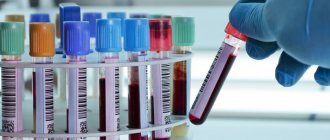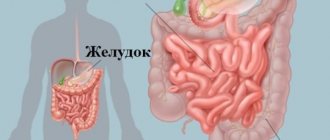Photo: Chris Penfold
The color and consistency of stool is a fairly accurate indicator of the proper functioning of many systems in the body. This indicator is especially important when assessing the functioning of the digestive organs, liver and kidneys. Brown stool color is considered standard, but any changes may indicate either poor nutrition or organ dysfunction.
If an adult has light-colored feces, this may also indicate the presence of diseases of the intestines, stomach or pancreas. In addition, lightening of the stool can be a signal of liver disorders. The degree of complexity of the disease that caused the light-colored stool can be either minor in scale or a rather difficult clinical picture.
What causes light-colored stool in an adult?
The development of diseases is not always indicated by lightening of the stool. Eating a lot of light-colored foods can also cause light-colored stool in an adult. For example, if the majority of the diet consists of dairy or fermented milk products, then this is considered normal. The reasons for light-colored stool vary with a standard diet containing various foods.
There are several main factors that will make stool light:
- Functional disorders.
- Taking medications.
- Development of diseases.
In many ways, diet influences the color of stool, but if this fact is complemented by the presence of discomfort in the abdominal area, nausea, vomiting, diarrhea and fever, this may indicate the development of diseases.
Causes of light-colored stool:
- The development of hepatitis is a liver disease, during which an inflammatory process is observed in the organ, which provokes a decrease in its performance. As a result, toxic substances are simply not processed by the body. This disease can be toxic, alcoholic, etc. Often in this case, pale stool is accompanied by sharp pain in the right side of the abdomen and yellowing of the skin and whites of the eyes.
- Cholecystitis is a disease of the gallbladder that causes a decrease in the production of digestive enzymes. This disorder is accompanied by acute abdominal pain, fever, vomiting and light diarrhea in an adult.
- Pancreatitis is an inflammation of the pancreas that causes light-colored stool, cutting pain in the abdomen, diarrhea and vomiting. Pancreatitis stool often contains small, undigested food particles.
- Crohn's disease. This disease is chronic and appears as a result of severe food allergies, stress or as a result of infectious diseases. In this case, light-colored stool in an adult often has bloody inclusions, as well as vomiting and an increase in body temperature.
- Development of tumors in the digestive organs. This affects the functioning of the entire system, resulting in light-colored stools in adults, disturbances in the functioning of organs, which are manifested by constipation or diarrhea, sudden weight loss and loss of appetite.
In order to understand the need for examination, you need to pay attention to the presence of any disorders other than stool lightening, and adhere to a dietary diet for several weeks. This is important, no matter what the reasons for light-colored stool in an adult. This event simply allows you to unload the organs.
On a note. In addition to the development of these diseases, discolored excrement can be caused by infectious intestinal diseases. In this case, accompanying symptoms quickly develop in the form of frequent vomiting, diarrhea and high fever. This condition requires immediate medical attention.
What does gray poop in children indicate?
Infants quite often have digestive problems - this is due to the fact that the body has not yet adapted to the environment; the necessary bacteria have not settled in the gastrointestinal tract, which allows for normal digestion.
Let's look at the reasons why gray diarrhea may appear in children:
- When using certain medications;
- incorrectly composed diet;
- infectious or inflammatory diseases of the gastrointestinal tract.
On a note! Quite often, a baby develops a gray coating on the stool due to poor nutrition. Therefore, all pediatricians say that breastfeeding is mandatory - this will make it much easier for the baby to adapt to environmental conditions.
When bottle-fed, gray stool appears quite often in the baby.
Another reason why a baby’s poop color changes is the mother’s nutrition (during breastfeeding). With a large amount of dairy and plant products in the mother’s diet, the color of the newborn’s excrement may change without being accompanied by additional symptoms. There is no need to worry - the gray coating will disappear as soon as a couple of months have passed and the child adapts to the outside world.
Unfortunately, it is not always possible for a mother to breastfeed her child. On artificial feeding, a baby's stool may be unstable, and the color and consistency of stool may change. But all these phenomena are adaptive, they do not pose a threat and disappear without a trace over time.
By one year, the baby’s digestion has stabilized and there should be no changes in the color of the baby’s stool. However, if before the age of 3 parents observe isolated changes in the color or consistency of the baby’s excrement, they should not cause concern.
If, upon reaching one year of age, the child has loose stools, and the discharge does not have a characteristic odor, this may indicate the presence of certain pathologies, for example: dysbacteriosis, hepatitis, rotavirus gastroenteritis.
In such cases, you need to contact a specialist as quickly as possible - he will conduct diagnostic examinations and be able to prescribe treatment that will eliminate the unpleasant symptom.
Light colored stool – when should you sound the alarm?
Even if you see light-colored feces, you should pay attention to the fact that light colors have quite different shades, and the consistency may also change. Depending on how exactly the color has changed, we can assume the cause of these changes.
Light green color appears as a result of eating large amounts of plant foods. This indicator becomes a sign of disease in the presence of a microbial imbalance, that is, with the development of dysentery or dysbacteriosis. Pathogenic microorganisms populate the intestines in greater numbers than beneficial ones.
A light yellow color is given to feces by large quantities of dairy products, as well as yellow-colored foods. If a person does not have such eating habits, then light diarrhea will be a sign of the development of liver and pancreas diseases. This is due to the fact that the supply of the bilirubin enzyme in non-oxidized form to the stomach is reduced, therefore discoloration occurs, frequent belching and bloating appear, and a constant fermentation process occurs.
Gray color is a signal from the pancreas; only in this case can we say that diabetes mellitus or malignant tumors in the organ itself, as well as near it, may develop.
If gray stools appear systemically, it is imperative to contact a specialist for a thorough diagnosis and selection of treatment.
Reason: medications
The cause of acholic stool can be the use of drugs such as:
- antipyretic drugs such as Aspirin, Paracetamol and Ibuprofen;
- antibiotics;
- oral contraceptives;
- medicines against gout;
- non-steroidal anti-inflammatory drugs;
- medicines for diarrhea;
- antifungal medications;
- drugs for the treatment of tuberculosis;
- medications for epilepsy.
People who have undergone special diagnostic procedures, in particular contrast fluoroscopy of the stomach, may observe light-colored stools over the next few days. This is due to the necessary use of barium sulfate for such procedures. As soon as the radiopaque substance leaves the body, the usual brown color will return.
Discoloration of stool during pregnancy
During pregnancy, the hormonal levels in the female body change significantly, and the load on all organs increases due to the fact that they ensure the vital functions of not only the woman, but also the child in the womb. Light-colored stools often occur during pregnancy.
And very often this happens as a result of increased load on the pancreas. This situation is often caused by taking multivitamin complexes. And the problem can be solved by timely contacting a doctor who is managing the pregnancy to correct the treatment plan.
But what light-colored feces and yellow urine mean can be understood by understanding that discoloration of feces is caused by a lack of the enzyme bilirubin. The coloring of urine the color of strongly brewed tea indicates that the enzyme does not undergo purification through the kidneys and ends up directly in the urine; it also penetrates into the skin. Very light stool indicates the development of hepatitis.
With such symptoms, a liver disorder is most often suspected. A pregnant woman should consult a doctor who will select the right treatment. Very often this problem is solved after childbirth, since the load on the body as a whole is removed.
Important! During pregnancy, a woman should carefully monitor the consistency and color of stool, as they are a quick indicator of changes in the condition of the mother and child. With a timely response to the signal, doctors will be able to quickly eliminate the problem without consequences.
Solution
If a person has committed such a violation as acholic stool, what should be done in this case? In order for the stool to return to normal and acquire its usual color, it is necessary:
- eliminate from the daily menu those foods that change the color of stool;
- stop taking medications or replace those that affect the color of feces;
- drink plenty of non-carbonated clean water, about 2 liters per day;
- follow a special diet that excludes foods that activate the fermentation process in the intestines.
If the above recommendations helped to cope with the problem, then you should take care of the correctness and quality of your diet so that the pancreas and liver can function normally.

Treatment
A necessary condition for the treatment of steatorrhea is diet.
Diet
Basic principles of dietary nutrition
- Fractional meals - that is, in small portions, up to 5-6 times a day.
- In case of moderately severe steatorrhea and the absence of complications, it is necessary to strive for a balanced diet, and correct enzyme deficiency with medications. In severe cases, the amount of fat in the daily diet is reduced to 60-80 g, and the calorie content is increased due to carbohydrates and proteins.
- The preferred methods of cooking are steaming and baking in the oven.
- Food should be at a comfortable temperature. It is necessary to avoid too cold and hot.
- Avoid smoking and alcohol.
List of recommended and prohibited foods and dishes
| Allowed | Forbidden |
|
|
Based on this list, each patient empirically selects the optimal diet for himself.
Drug treatment
- Enzyme replacement therapy. Prescribed drugs containing pancreatic lipase. The choice of medication and its dosage depends on the severity of steatorrhea. For severe forms of the disease, the drugs of choice are Creon and Pancitrate; for mild alimentary steatorrhea, Mezim Forte is used. Patients must take enzymes for life.
- Drugs that reduce gas formation in the intestines - Espumisan, Sab Simplex, Dimethicone, activated carbon.
- Intestinal antiseptics. To suppress pathogenic flora in the intestines, which predominates in patients with steatorrhea, Furazolidone and Enterofuril are prescribed.
- Probiotics. To restore the composition of the intestinal microflora, Lactobacterin, Bifidumbacterin, Linex, Enterol and others are used.
- Vitamins orally or intramuscularly.
- Iron supplements, folic acid for anemia.
We recommend reading:
Why does black loose stool (melena) occur?
Other
When cholelithiasis is detected, the gastroenterologist’s task is to promptly refer the patient for surgical treatment.
Prevention
Main article: Measures to prevent dysbiosis
- The basis of prevention is the rational and correct prescription of medications. It is recommended to prescribe probiotics and prebiotics together with antibacterial drugs or a course after antimicrobial therapy. The prescription of an antibiotic must be justified, under the supervision of the attending physician.
- Proper nutrition (see here) and a healthy lifestyle.
Timely diagnosis and treatment of dysbiosis is the basis for the prevention of serious complications. In the early stages, therapy is much simpler and easier than with total imbalance.
In continuation of the topic, be sure to read:
- Escherichiosis: details about the infectious disease
- Escherichia coli: about the bacterium, its types, pathogenic and non-pathogenic strains
- Bacteriological culture (tank culture) of feces: essence, preparation and analysis
- How is rotavirus intestinal infection manifested and treated?
- Intestinal infection: symptoms and treatment methods (diet, medications)
- Intestinal dysbiosis in children: symptoms and treatment (diet, medications)
- Dysentery: how is the disease manifested and treated?
- The concept of intestinal microflora, its functions and representatives
- Enterococci: about bacteria, normal and pathological existence
- Hemolytic Escherichia coli: why is it dangerous and when is therapy needed?
Possible changes in the color of feces
Stool color is a marker of internal organ health. The color of stool depends on many factors: food preferences, medications taken and the condition of the body.
An adult who is attentive to his health should monitor the color, smell and consistency of his stool, which, if a problem arises, will help to make a correct diagnosis faster and better.
Black or very dark stools
Semi-liquid black, foul-smelling stool is called melena. The following conditions may be the causes of blackened stool:
- predominance of meat in the diet (especially blood and liver);
- eating pomegranates, blueberries, black currants;
- taking antacid (heartburn) medications or activated charcoal;
- blood cancer (leukemia);
- excessive consumption of coffee or tea;
- treatment with medications containing bismuth;
- the presence of roundworms in the intestines (hookworms);
- therapy with iron and licorice root preparations;
- plague (now extremely rare);
- the use of certain multivitamin complexes (before using such medications, you should definitely study the instructions, where possible changes in the color of stool are usually indicated);
- bleeding from the upper parts of the digestive tract (esophagus, stomach). In this case, the blood that gets into the hydrochloric acid of the stomach turns black.
If the darkening of the stool is associated with errors in the diet or taking medications, then medical attention will not be needed, since the feces will acquire their usual color within a few days after stopping therapy or dietary correction.

If the appearance of black stool is a symptom of bleeding, then the patient will need immediate medical attention, because massive blood loss can threaten the patient’s life.










